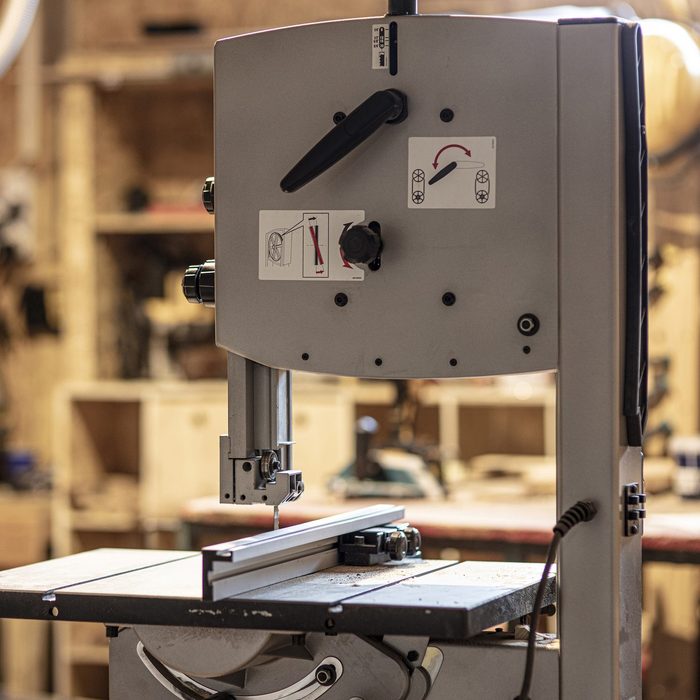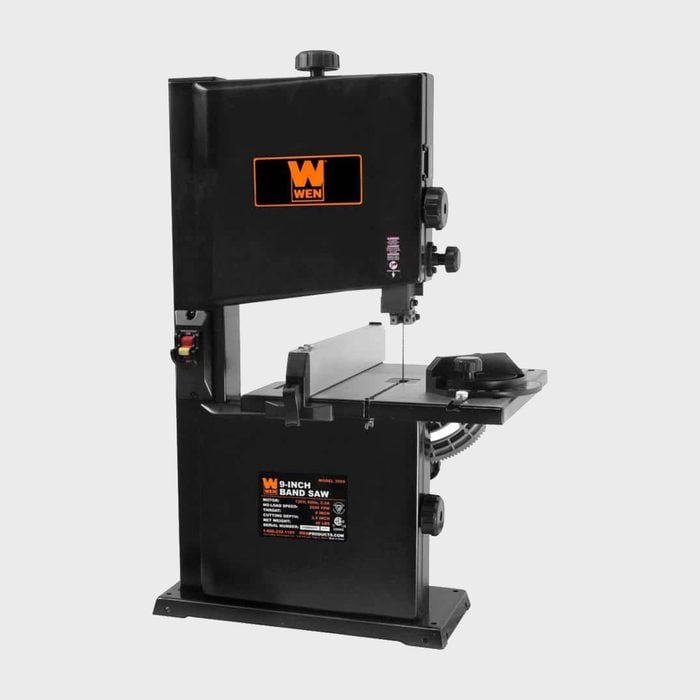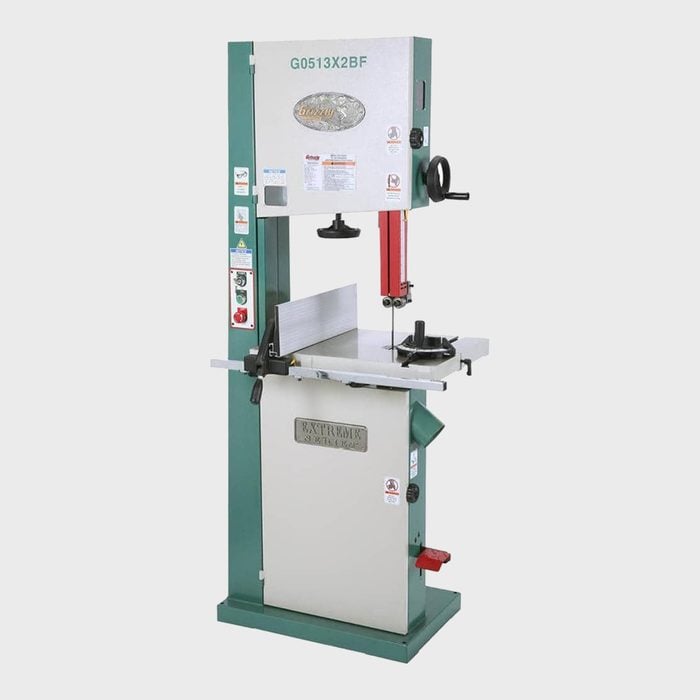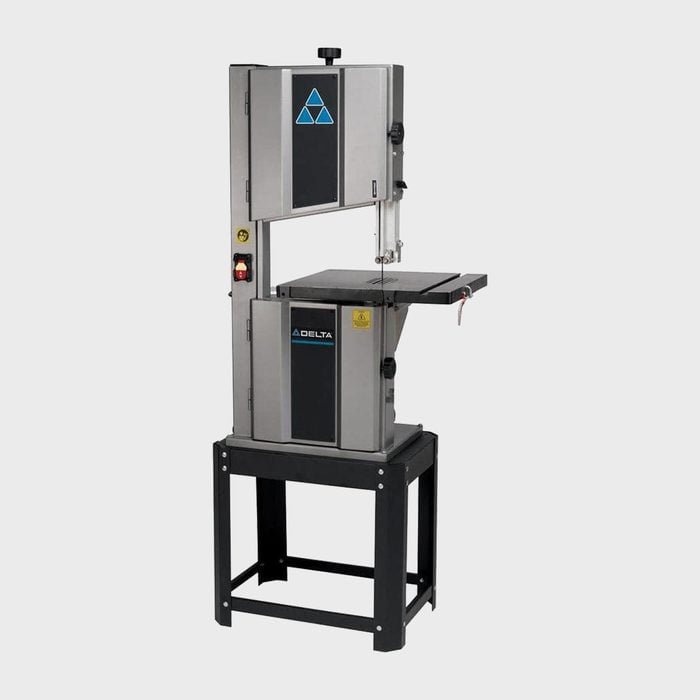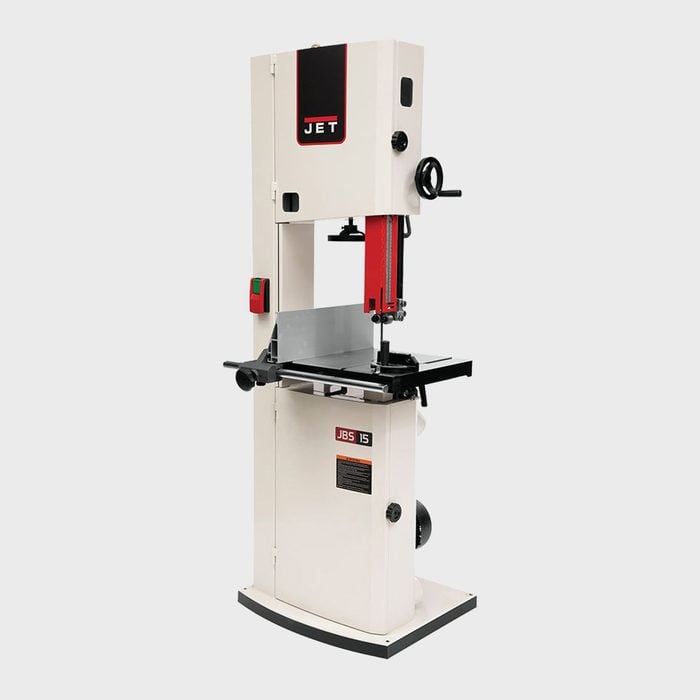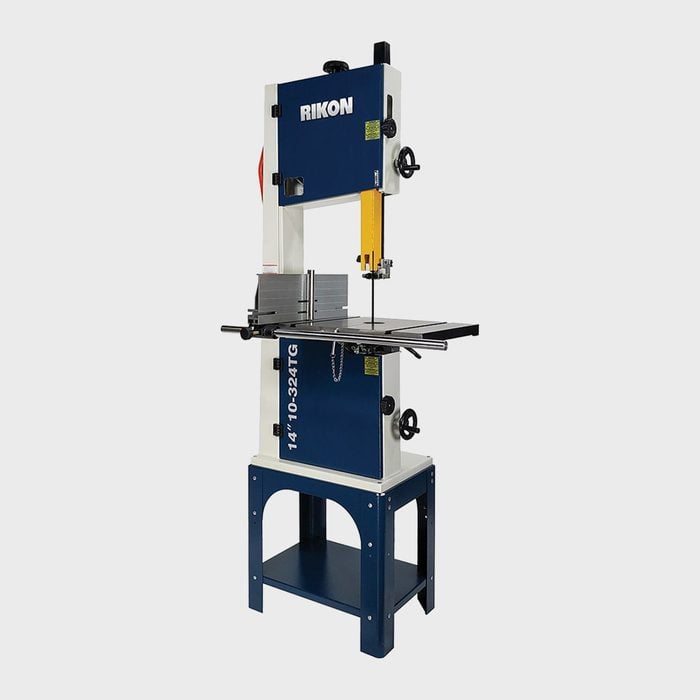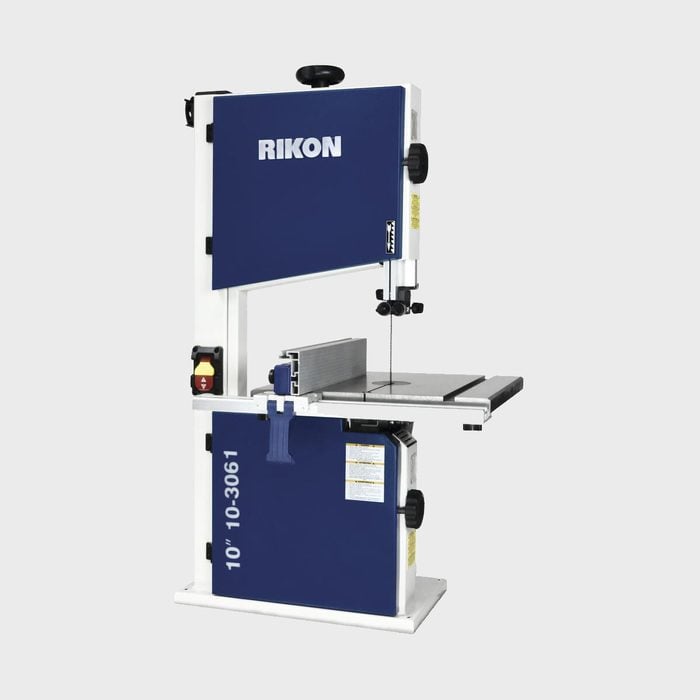 Via Menards.com
Via Menards.com
I love the Rikon 10-3061 Band Saw for a few reasons: It’s got less vertical capacity than the 10-324TG above. But if you don’t plan on resawing wide material, this slightly smaller band saw is an exceptional deal.
It has a 5-inch vertical capacity compared to the 10-324TG’s 13-inch, but it costs about 50 percent less. Sure, it’s pricey for a bench top, but the power and features make it worth the money.
This is an upgrade to Rikon’s previous 10-inch model, the 10-306. Like its more costly counterpart, this saw offers two speeds. The 2-1/2-inch dust port tilts upward, making it easier to connect and disconnect hoses in a small shop. It has a pair of viewing windows and takes up to a 1/2-inch blade. The 13-3/4 x 12-1/2-inch table tilts five degrees left and 45 degrees right.
Product Specs:
- Type: Floor-standing
- Power: 5.5 amps
- Size: 9.625 inches
- Weight: 86 pounds
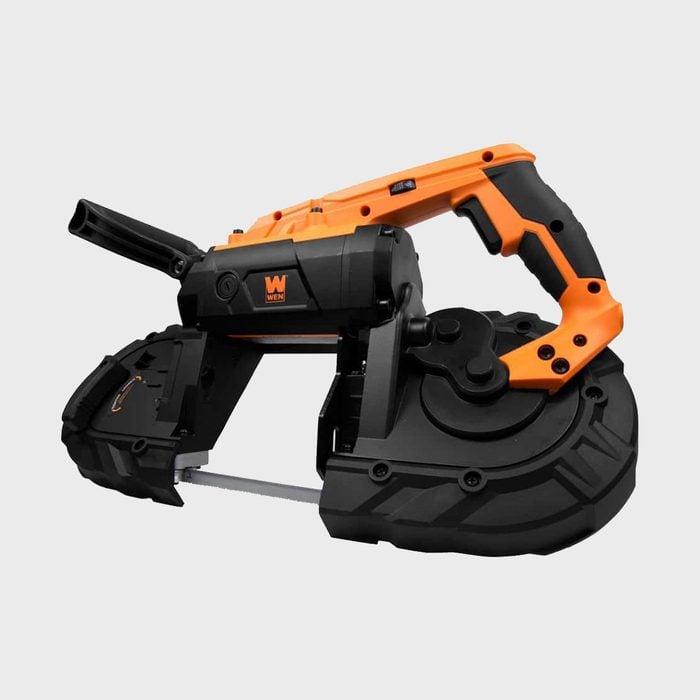 Via Homedepot.com
Via Homedepot.com
I saved portable band saws for last because they’re so different from bench and floor-standing models. Often used to cut metal or PVC at a jobsite, these saws can also cut almost any material with the right blade, especially curves and straight flush cuts. Instead of throat depth and vertical clearance, portable band saws describe cut depth (blade to saw frame) and cut width (end to end of the exposed blade).
For dependable cutting and good battery life, the Wen 94396 10-amp Band Saw provides both portability and power. And at less than $100, it’s the lowest-priced tool on this list.
With a 5-inch depth and 5-inch cut width, it has one of the largest cutting capacities on the market. The variable speed dial lets you select a blade speed between 60 and 420 feet per minute so you can find the right cutting speed for the material at hand. This saw ships with a 1/2-inch blade, and it’s backed by a two-year warranty.
Product Specs:
- Type: Portable
- Power: 10 amps
- Size: 5 inches
- Weight: 14.5 pounds
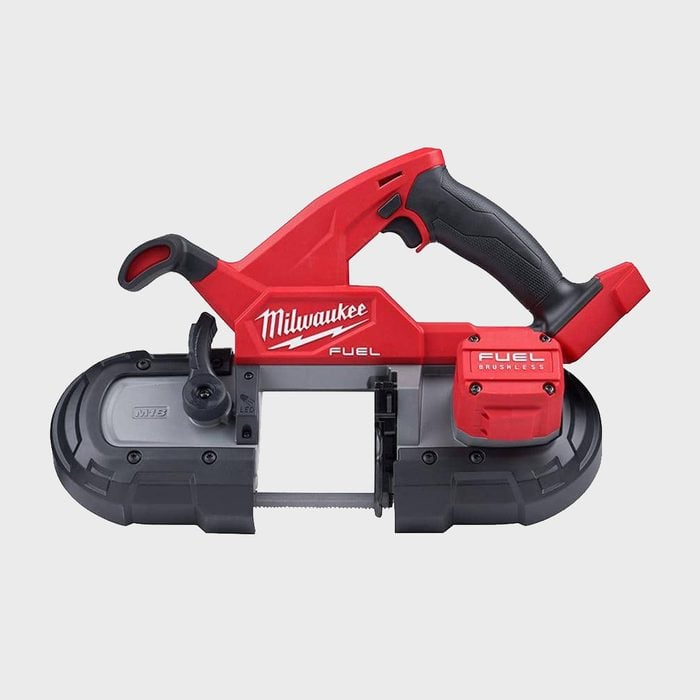 Via Homedepot.com
Via Homedepot.com
For the ultimate in portable band saws, choose a cordless model. The Milwaukee M18 Compact Band Saw offers a 3-1/4-inch x 3-1/4-inch cutting capacity, and the brushless motor features trigger-controlled variable speed.
Milwaukee’s “Jobsite Armor Technology” protects the tool’s mechanisms from the rough and tumble reality of jobsite use, and the integrated rafter hook allows for easy storage. Plus, this band saw is compatible with more than 200 tools in the M18 system. So if you’ve already invested in an M18 battery and charger, you’re all set.
Product Specs:
- Type: Portable
- Power: 0 amps
- Size: 3.25 inches
- Weight: 7.67 pounds
ⓘ
Types of Band Saws
- Floor-standing saws are the most capable models, but also the most expensive and heaviest. Some floor-standing band saws weigh more than 500 pounds.
- Stand-mounted band saws are about two-thirds the size of floor-standing models, using a small stand to bring their work table to the proper height. Stand-mounted saws tend to have smaller specs and be less powerful than floor-standing saws, but they’re lighter and more affordable.
- Bench-top models are the most popular with DIYers looking to balance price, size and performance. These range from 75 to 300 pounds, and usually have a smaller throat size and vertical cutting capacity than floor-standing or stand-mounted saws.
- Portable band saws are lightweight handheld tools, available in corded and cordless models. Notably, portable band saws lack an integrated table to support the work material.
What to Consider When Buying a Band Saw
- Throat depth: This is the saw’s cutting width, which is how band saws are described. So a 14-inch band saw has about 14 inches of throat depth. The actual measurement will be smaller like the way a 2×4 isn’t actually two by four inches. Throat depth is the distance from blade to column. Bench-top band saws generally have about a foot of throat depth, while standing saws allow wider material to pass through. If you’re cutting curves, that extra space gives you more room to maneuver material.
- Vertical capacity: This measures the saw’s cutting height. It’s a key measurement if you’ll be resawing boards into smaller thicknesses.
- Motor power: Smaller bench-top saws don’t always advertise their horsepower (hp). But if they do, 1/2- to 1-hp is plenty for hobbyists. You want 1- to 1-1/2 hp for resawing. A band saw with 2-hp or more is suitable for serious woodworking, but will likely need a 220-volt electrical supply.
- Frame: Traditionally these are cast iron, but steel frames allow for a higher vertical capacity. Cast iron frames often have seams, and ensure there’s no possibility of your work area bending.
- Table size: Tables support the cutting material. Some DIYers prefer a wider surface, while others like to be right on top of the work. Some tables also tilt in one or more directions, allowing for easier angled cuts. Portable band saws don’t have tables at all.
Why You Should Trust Us
Drawing on my background as a former residential remodeler, commercial site supervisor and maintenance manager, I bring extensive knowledge shaped by years of hands-on experience in the construction and DIY field. Throughout my career, I’ve engaged in nearly every facet of building and DIY projects, spanning from project planning and permitting to hands-on tasks such as plumbing, basic electrical work, drywall installation, carpentry, tiling, painting and beyond. With substantial experience in both residential and commercial settings, I have a comprehensive understanding of the intricacies involved in these projects, assuring that the information provided is firmly rooted in practical, real-world expertise.
How We Found the Best Band Saw
As shopping experts, our only job is to help you find a winning product. We start with the research and reporting basics—what products are made of, what they look like and how much they cost—to ensure that we’re only recommending the buys that are worth your time and money. Then, we research the features that speak to the product’s quality, taking advice from industry insiders and subject matter experts on what makes a product a smart value (or worthy of a splurge). Finally, we do the work of combing through user reviews to see how real people interact with the product, and if it stands up to the test.
FAQ
How much does a band saw cost?
This varies with size and quality. Benchtop models range from $175 to $1,000, while freestanding floor saws start at around $1,000 and go up to $5,000 or more. A portable band saw is only $100 to $400.
What size blade do I need?
Like every type of saw, a band saw is only as good as the blade. Less expensive models often come with a lower-quality blade, so you may want to upgrade right away. Pros keep multiple blades on hand to save time and material, while DIYers tend to keep a more limited selection of blades. The best width depends on the usage. If you’re doing a lot of curvy and delicate work, a narrow blade is best—many DIYers like a 1/4-inch blade.
Greater width provides more stability for steady straight cuts, often a 3/4-inch blade or greater. A half-inch blade is a good compromise. As with most other saw blades, a higher tooth count provides a smoother but potentially slower cut. Manufacturers describe band saw blades by teeth per inch (tpi) rather than full tooth count. Bi-metal blades can cut wood but are often used for metal.
What cuts can a band saw make?
A band saw can make a variety of cuts, including straight cuts for large panels, curved cuts for intricate shapes, resawing to create thinner pieces from a thick board, rip cuts along the length of the material, miter cuts for angled edges, crosscuts for shorter pieces and scroll cuts for detailed designs. Its versatility makes it suitable for woodworking, metalworking and cutting various materials with precision and flexibility.
What is the difference between a jigsaw and a band saw?
A jigsaw is a versatile handheld tool with a reciprocating blade that moves up and down, allowing for intricate and curved cuts in wood, metal and other materials. It’s particularly useful for detailed work and cutting shapes.
On the other hand, a band saw is a stationary tool with a continuous looped blade that moves in a vertical or horizontal direction. Band saws are generally larger and more powerful, making them ideal for straight cuts in thick materials and resawing lumber.




















